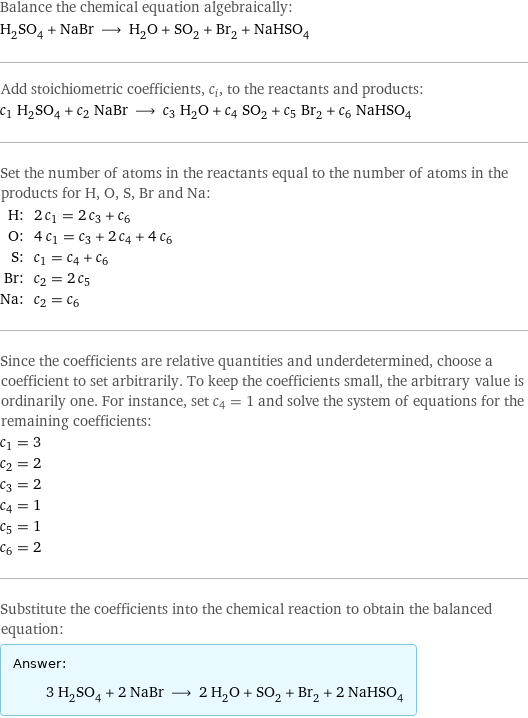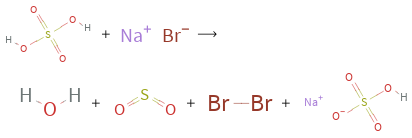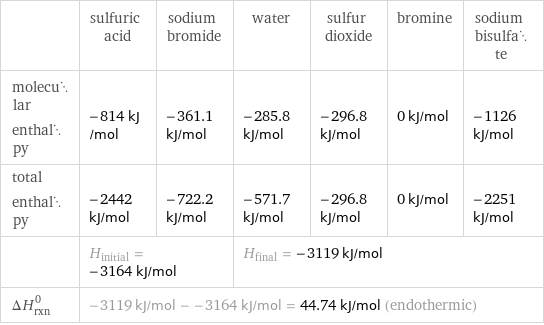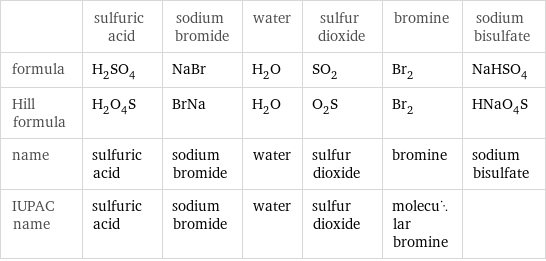Input interpretation

H_2SO_4 sulfuric acid + NaBr sodium bromide ⟶ H_2O water + SO_2 sulfur dioxide + Br_2 bromine + NaHSO_4 sodium bisulfate
Balanced equation

Balance the chemical equation algebraically: H_2SO_4 + NaBr ⟶ H_2O + SO_2 + Br_2 + NaHSO_4 Add stoichiometric coefficients, c_i, to the reactants and products: c_1 H_2SO_4 + c_2 NaBr ⟶ c_3 H_2O + c_4 SO_2 + c_5 Br_2 + c_6 NaHSO_4 Set the number of atoms in the reactants equal to the number of atoms in the products for H, O, S, Br and Na: H: | 2 c_1 = 2 c_3 + c_6 O: | 4 c_1 = c_3 + 2 c_4 + 4 c_6 S: | c_1 = c_4 + c_6 Br: | c_2 = 2 c_5 Na: | c_2 = c_6 Since the coefficients are relative quantities and underdetermined, choose a coefficient to set arbitrarily. To keep the coefficients small, the arbitrary value is ordinarily one. For instance, set c_4 = 1 and solve the system of equations for the remaining coefficients: c_1 = 3 c_2 = 2 c_3 = 2 c_4 = 1 c_5 = 1 c_6 = 2 Substitute the coefficients into the chemical reaction to obtain the balanced equation: Answer: | | 3 H_2SO_4 + 2 NaBr ⟶ 2 H_2O + SO_2 + Br_2 + 2 NaHSO_4
Structures

+ ⟶ + + +
Names

sulfuric acid + sodium bromide ⟶ water + sulfur dioxide + bromine + sodium bisulfate
Reaction thermodynamics
Enthalpy

| sulfuric acid | sodium bromide | water | sulfur dioxide | bromine | sodium bisulfate molecular enthalpy | -814 kJ/mol | -361.1 kJ/mol | -285.8 kJ/mol | -296.8 kJ/mol | 0 kJ/mol | -1126 kJ/mol total enthalpy | -2442 kJ/mol | -722.2 kJ/mol | -571.7 kJ/mol | -296.8 kJ/mol | 0 kJ/mol | -2251 kJ/mol | H_initial = -3164 kJ/mol | | H_final = -3119 kJ/mol | | | ΔH_rxn^0 | -3119 kJ/mol - -3164 kJ/mol = 44.74 kJ/mol (endothermic) | | | | |
Gibbs free energy

| sulfuric acid | sodium bromide | water | sulfur dioxide | bromine | sodium bisulfate molecular free energy | -690 kJ/mol | -349 kJ/mol | -237.1 kJ/mol | -300.1 kJ/mol | 0 kJ/mol | -992.8 kJ/mol total free energy | -2070 kJ/mol | -698 kJ/mol | -474.2 kJ/mol | -300.1 kJ/mol | 0 kJ/mol | -1986 kJ/mol | G_initial = -2768 kJ/mol | | G_final = -2760 kJ/mol | | | ΔG_rxn^0 | -2760 kJ/mol - -2768 kJ/mol = 8.1 kJ/mol (endergonic) | | | | |
Equilibrium constant
![Construct the equilibrium constant, K, expression for: H_2SO_4 + NaBr ⟶ H_2O + SO_2 + Br_2 + NaHSO_4 Plan: • Balance the chemical equation. • Determine the stoichiometric numbers. • Assemble the activity expression for each chemical species. • Use the activity expressions to build the equilibrium constant expression. Write the balanced chemical equation: 3 H_2SO_4 + 2 NaBr ⟶ 2 H_2O + SO_2 + Br_2 + 2 NaHSO_4 Assign stoichiometric numbers, ν_i, using the stoichiometric coefficients, c_i, from the balanced chemical equation in the following manner: ν_i = -c_i for reactants and ν_i = c_i for products: chemical species | c_i | ν_i H_2SO_4 | 3 | -3 NaBr | 2 | -2 H_2O | 2 | 2 SO_2 | 1 | 1 Br_2 | 1 | 1 NaHSO_4 | 2 | 2 Assemble the activity expressions accounting for the state of matter and ν_i: chemical species | c_i | ν_i | activity expression H_2SO_4 | 3 | -3 | ([H2SO4])^(-3) NaBr | 2 | -2 | ([NaBr])^(-2) H_2O | 2 | 2 | ([H2O])^2 SO_2 | 1 | 1 | [SO2] Br_2 | 1 | 1 | [Br2] NaHSO_4 | 2 | 2 | ([NaHSO4])^2 The equilibrium constant symbol in the concentration basis is: K_c Mulitply the activity expressions to arrive at the K_c expression: Answer: | | K_c = ([H2SO4])^(-3) ([NaBr])^(-2) ([H2O])^2 [SO2] [Br2] ([NaHSO4])^2 = (([H2O])^2 [SO2] [Br2] ([NaHSO4])^2)/(([H2SO4])^3 ([NaBr])^2)](../image_source/4ed9c1ecc34cd5c4ebc0bc21b5f8c430.png)
Construct the equilibrium constant, K, expression for: H_2SO_4 + NaBr ⟶ H_2O + SO_2 + Br_2 + NaHSO_4 Plan: • Balance the chemical equation. • Determine the stoichiometric numbers. • Assemble the activity expression for each chemical species. • Use the activity expressions to build the equilibrium constant expression. Write the balanced chemical equation: 3 H_2SO_4 + 2 NaBr ⟶ 2 H_2O + SO_2 + Br_2 + 2 NaHSO_4 Assign stoichiometric numbers, ν_i, using the stoichiometric coefficients, c_i, from the balanced chemical equation in the following manner: ν_i = -c_i for reactants and ν_i = c_i for products: chemical species | c_i | ν_i H_2SO_4 | 3 | -3 NaBr | 2 | -2 H_2O | 2 | 2 SO_2 | 1 | 1 Br_2 | 1 | 1 NaHSO_4 | 2 | 2 Assemble the activity expressions accounting for the state of matter and ν_i: chemical species | c_i | ν_i | activity expression H_2SO_4 | 3 | -3 | ([H2SO4])^(-3) NaBr | 2 | -2 | ([NaBr])^(-2) H_2O | 2 | 2 | ([H2O])^2 SO_2 | 1 | 1 | [SO2] Br_2 | 1 | 1 | [Br2] NaHSO_4 | 2 | 2 | ([NaHSO4])^2 The equilibrium constant symbol in the concentration basis is: K_c Mulitply the activity expressions to arrive at the K_c expression: Answer: | | K_c = ([H2SO4])^(-3) ([NaBr])^(-2) ([H2O])^2 [SO2] [Br2] ([NaHSO4])^2 = (([H2O])^2 [SO2] [Br2] ([NaHSO4])^2)/(([H2SO4])^3 ([NaBr])^2)
Rate of reaction
![Construct the rate of reaction expression for: H_2SO_4 + NaBr ⟶ H_2O + SO_2 + Br_2 + NaHSO_4 Plan: • Balance the chemical equation. • Determine the stoichiometric numbers. • Assemble the rate term for each chemical species. • Write the rate of reaction expression. Write the balanced chemical equation: 3 H_2SO_4 + 2 NaBr ⟶ 2 H_2O + SO_2 + Br_2 + 2 NaHSO_4 Assign stoichiometric numbers, ν_i, using the stoichiometric coefficients, c_i, from the balanced chemical equation in the following manner: ν_i = -c_i for reactants and ν_i = c_i for products: chemical species | c_i | ν_i H_2SO_4 | 3 | -3 NaBr | 2 | -2 H_2O | 2 | 2 SO_2 | 1 | 1 Br_2 | 1 | 1 NaHSO_4 | 2 | 2 The rate term for each chemical species, B_i, is 1/ν_i(Δ[B_i])/(Δt) where [B_i] is the amount concentration and t is time: chemical species | c_i | ν_i | rate term H_2SO_4 | 3 | -3 | -1/3 (Δ[H2SO4])/(Δt) NaBr | 2 | -2 | -1/2 (Δ[NaBr])/(Δt) H_2O | 2 | 2 | 1/2 (Δ[H2O])/(Δt) SO_2 | 1 | 1 | (Δ[SO2])/(Δt) Br_2 | 1 | 1 | (Δ[Br2])/(Δt) NaHSO_4 | 2 | 2 | 1/2 (Δ[NaHSO4])/(Δt) (for infinitesimal rate of change, replace Δ with d) Set the rate terms equal to each other to arrive at the rate expression: Answer: | | rate = -1/3 (Δ[H2SO4])/(Δt) = -1/2 (Δ[NaBr])/(Δt) = 1/2 (Δ[H2O])/(Δt) = (Δ[SO2])/(Δt) = (Δ[Br2])/(Δt) = 1/2 (Δ[NaHSO4])/(Δt) (assuming constant volume and no accumulation of intermediates or side products)](../image_source/27b633677c4d2fcccc35052f4e825e2a.png)
Construct the rate of reaction expression for: H_2SO_4 + NaBr ⟶ H_2O + SO_2 + Br_2 + NaHSO_4 Plan: • Balance the chemical equation. • Determine the stoichiometric numbers. • Assemble the rate term for each chemical species. • Write the rate of reaction expression. Write the balanced chemical equation: 3 H_2SO_4 + 2 NaBr ⟶ 2 H_2O + SO_2 + Br_2 + 2 NaHSO_4 Assign stoichiometric numbers, ν_i, using the stoichiometric coefficients, c_i, from the balanced chemical equation in the following manner: ν_i = -c_i for reactants and ν_i = c_i for products: chemical species | c_i | ν_i H_2SO_4 | 3 | -3 NaBr | 2 | -2 H_2O | 2 | 2 SO_2 | 1 | 1 Br_2 | 1 | 1 NaHSO_4 | 2 | 2 The rate term for each chemical species, B_i, is 1/ν_i(Δ[B_i])/(Δt) where [B_i] is the amount concentration and t is time: chemical species | c_i | ν_i | rate term H_2SO_4 | 3 | -3 | -1/3 (Δ[H2SO4])/(Δt) NaBr | 2 | -2 | -1/2 (Δ[NaBr])/(Δt) H_2O | 2 | 2 | 1/2 (Δ[H2O])/(Δt) SO_2 | 1 | 1 | (Δ[SO2])/(Δt) Br_2 | 1 | 1 | (Δ[Br2])/(Δt) NaHSO_4 | 2 | 2 | 1/2 (Δ[NaHSO4])/(Δt) (for infinitesimal rate of change, replace Δ with d) Set the rate terms equal to each other to arrive at the rate expression: Answer: | | rate = -1/3 (Δ[H2SO4])/(Δt) = -1/2 (Δ[NaBr])/(Δt) = 1/2 (Δ[H2O])/(Δt) = (Δ[SO2])/(Δt) = (Δ[Br2])/(Δt) = 1/2 (Δ[NaHSO4])/(Δt) (assuming constant volume and no accumulation of intermediates or side products)
Chemical names and formulas

| sulfuric acid | sodium bromide | water | sulfur dioxide | bromine | sodium bisulfate formula | H_2SO_4 | NaBr | H_2O | SO_2 | Br_2 | NaHSO_4 Hill formula | H_2O_4S | BrNa | H_2O | O_2S | Br_2 | HNaO_4S name | sulfuric acid | sodium bromide | water | sulfur dioxide | bromine | sodium bisulfate IUPAC name | sulfuric acid | sodium bromide | water | sulfur dioxide | molecular bromine |